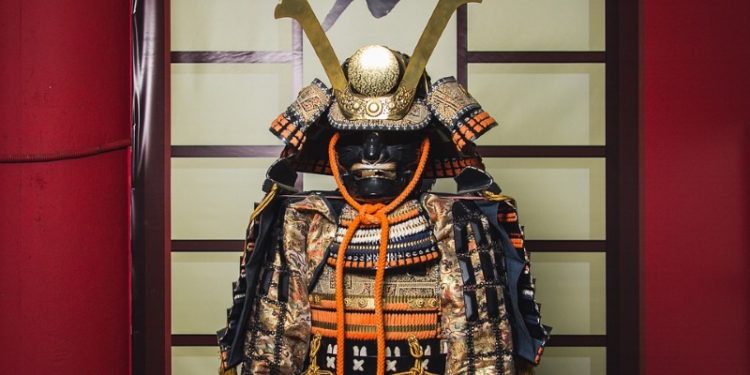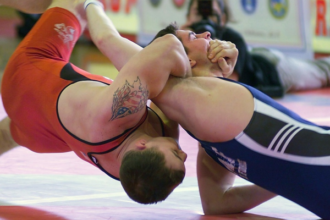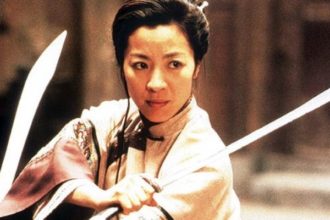The Fighter Class, Part Six

I’m mostly over my cold, even if the rest of my family is still under the weather. Today, I’m pressing on toward the samurai classes of 3.x, found in 3.0’s Oriental Adventures and 3.5’s Complete Warrior. I’ll probably work in a few other things along the way. Now, if you’re thinking, “but isn’t this just the fighter class?” then… Oriental Adventures has no particular contributions to offer fighters. The mechanical differences are one new option for your bonus fighter feats, and that’s it. Thematically, it’s defined by not being samurai, full stop.
Part One | Part Two | Part Three | Part Four | Part Five | Part Six
Oriental Adventures (3.0)
The flavor text attached to the samurai class is exactly what you’d expect if you have heard of samurai from a Western viewpoint ever in your life. The idea that it’s fundamentally different from a character with the fighter class who has a chain of command is… one of those odd things about having a class-based game.
- Samurai must be lawful, because alignment rules.
- d10 Hit Dice.
- Good Fortitude and Will saves, because honor.
- 4 + Int skill points per level, and a considerably more generous skill list than fighters – they add Diplomacy, the new-in-OA skill Iaijutsu Focus, Perform, and Sense Motive. For expanding the pillars of gameplay in which the character can directly participate, this is very good. Obviously, though, you’re not going to have a great Cha score hanging around to make your Diplomacy bonus the very best. You’re probably still second fiddle if the party has a dedicated face character.
- The samurai’s main feature is Ancestral Daisho. You start with a masterwork katana and wakizashi, which is a pretty big help in the early game. In theory, you might use other weapons, but if you seriously have this feature and go with another weapon, why didn’t you just pick fighter?
- Anyway, Ancestral Daisho also lets you sacrifice treasure to enchant your weapons. It’s a hyper-specialized variant of Craft Magic Arms and Armor that doesn’t cost XP and doesn’t have spellcasting requirements. Instead, you have to meet scaling level requirements for the total bonus of your weapon. In essence, you can treat accumulated treasure as a progress bar on your weapons. (Though presumably you’ll still want a few other magic items.)
- Enchanting your weapons takes time – by 18th level, a total of 200 days – as is typical for enchanting in 3.x. It’s absolutely criminal that there’s no suggestion in the text that you and your spiritual adviser would have interesting encounters with the souls of your ancestors during these meditations. How to Enrich the Samurai Story 101, folks.
- Samurai receive bonus feats at 2nd, 4th, 7th, 10th, 13th, 16th, and 19th levels: fewer than fighters, more than anyone else. Because OA uses the Rokugan setting as its default, your list of options for these feats comes from your Clan. Overall, you’re going to wind up with most of your Clan’s bonus feats by the late game, because they’re short lists. DMs should strongly consider adding feats from other sources to these lists, as directed by Clan theme.
And that’s that. The ki shout and great ki shout we might have expected from the 1e OA got reinterpreted as feats, and so are open to others.
In fairness, the Clans are richly written and add a lot of character to their samurai. More tabletop settings should emphasize such powerful defining features, as with Rokugan’s Clans or Hogwarts’ Houses. Planescape’s factions are a great example of this, though I’m not sure that players connected with them as strongly as they could. Eberron’s Dragonmarked Houses would be a clearer example of this if there were more of a firm shove toward all players belonging to a House. All of White Wolf’s properties have excelled in this. But I digress… because there just isn’t that much there in the samurai of OA.
I’m not diving deep into fighter and samurai prestige classes like I did for OA monks, but perhaps an overview? Battle Maiden is one of two cavalry prestige classes representing the Unicorn clan. It’s just barely possible for samurai characters, whatever the text may suggest, thanks to its requirement of 10 ranks in Handle Animal… not a class skill for samurai. If you’re sensible and introduce the Cosmopolitan feat from the FRCS, or a comparable “add a new skill to your class skill list” feat from elsewhere, then this becomes doable. Battle Maidens are more about keeping the same mount alive and being awesome with it, and about being exclusively women. Kishi Chargers seem to be more the type to use and lose horses, emphasizing additional abilities for the rider at the mount’s expense. Kishi Chargers have more emphasis on active features, while Battle Maidens have possibly the most flat-out insane passive feature I’ve seen in awhile. By 9th level, Battle Maidens have a +6 bonus that applies to Ride checks, initiative, AC while mounted, and attack rolls while mounted.
Bear Warriors are really here for barbarians or sohei. (PS., I am a huge fan of sohei; I played a sohei in a friend’s Romance of the Three Kingdoms campaign for something like ten levels. If I had been covering OA during the History of the Paladin series, there would have been a bit about sohei.) If you really misunderstood your right to bear arms, this prestige class is here for you. Because you shapeshift.
Next up is the Iaijutsu Master, for samurai with Dex as a primary stat and a Charisma as a strong secondary stat. This would work a lot better if you didn’t have to soldier through six samurai levels to finally get your build to play right. It has a lot of dead levels and less throughput than you might hope to see, though they can probably be explosive in an iaijutsu duel if they can survive the rest of the multiple attribute dependency.
The Singh Rager is equally friendly to fighters and samurai. It is permission to play a Lawful character with “fury” (that’s with one R, even though they’re Lions), which is just like a barbarian’s rage. Overall, the prestige class should be fun and potent. It spends a lot of time solving the action economy issues that fighters and samurai have in 3.0, like not getting to both move and make a full attack.
Finally, the Weapon Master takes hyper-specialization in a weapon to the next level. This basically does what you think it would do, with an emphasis on both burst and sustained damage. More attacks, more damage, more crits, more explosive crits. It’s probably really fun to play, as long as you want your character to be laser-focused on damage output.
I’ve mentioned Iaijutsu Focus a couple of times now, so I should explain what the heck it does. It’s a kind of check-driven Sneak Attack that only affects flat-footed targets, and only when you’re drawing a weapon. When OA came out, there weren’t a lot of ways to make someone flat-footed after the first round of combat, but I’m pretty sure that changed as 3.x matured. Anyway, an Iaijutsu Focus check grants scaling damage bonuses (up to +9d6 for check results of 50+) when you’re drawing a weapon against a flat-footed opponent or striking an inanimate object. It wouldn’t be D&D and katanas if D&D katanas couldn’t cut through tank armor! It also replaces your initiative check in a formal iaijutsu duel. If you’re going to present samurai duels as super special and cinematic (as L5R does), this is a pretty good way to do it.
Overall, the samurai would fall flat on its own, but as a baseline class to get out of as soon as your prestige class comes along, it’s fine. The setting flavor is everything here. Giving fighter archetypes a solid way into the social interaction pillar of play is great. Their clear position in the social order – a hard push against the “dumb brute” default of fighters – is exactly what I like to see. I wish the core 3.0 fighter had set out to incorporate this as a reasonable possibility for the class.
Complete Warrior
The 3.5 revision takes a completely different approach to samurai by returning to the 1e OA roots: a large number of specific features, kiai shout effects, and fear effects.
- d10 Hit Dice, of course.
- Must be Lawful.
- 2 + Int skill points, and a very limited skill list representing knowledge and social graces over athleticism. Concentration is a class skill, despite having no use in the class’s functions. Letting samurai use Concentration, or maybe Intimidate, sort of like Iaijutsu Focus would have been interesting. (They’re going to get plenty of use out of Intimidate, though.)
- +1/1 BAB, good Fortitude saves, bad Reflex and Will saves. Taking away Will saves seems like a strange move to me.
- Samurai are proficient in simple and martial weapons and all armor, but not shields. They’re also proficient with bastard swords, which are an Exotic Weapon in 3.x. (Do you know, I had temporarily forgotten that bastard swords were Exotic Weapons in 3.x. It’s amazing how little I miss these, in 5e.)
- Samurai have to get through 1st level with one weapon at a time, but gain Two-Weapon Fighting (without needing to meet the feat’s prereqs) at 2nd level.
- Kiai Smite is like a paladin’s Smite Evil, more or less, but without alignment rules and adding your Cha bonus rather than class level to the damage. It beats recalculating your Strength score up to 18/00, at least. You gain more uses per day, but the damage doesn’t natively increase.
- A feature called Iaijutsu Master grants Quick Draw as a bonus feat, but only for katanas and wakizashis.
- Stare Down grants you a +4 bonus to Intimidate checks. So Skill Focus +1.
- At 8th level, Improved Initiative.
- Mass Staredown starts to make the action of an Intimidate check to demoralize opponents potentially worthwhile, assuming you have a large-ish number of foes within 30 feet. Realistically, this amounts to “you can cast a slightly-better-than-double-strength bane spell as an opposed check.” The penalty goes from -1 to -2 and applies to a few more things. Getting to debuff enemy saving throws with an effect that doesn’t itself use a saving throw might have strong corner case uses for helping your caster buddies land big spells.
- Improved Two Swords as One is exactly the Improved Two-Weapon Fighting that it sounds like.
- Improved Staredown changes the action of a Mass Staredown from a standard action to a move action. It still stops you from using all of that fancy two-weapon fighting, of course.
- Greater Two Swords as One is exactly the Greater Two-Weapon Fighting that it sounds like. Again, only for katana and wakizashi, but if you’re playing a samurai, the situations in which you want to fight with two weapons of any other kind are all but nonexistent.
- Frightful Presence generates a fear effect (the strength of the effect depends on the hit dice of the target) when you draw a blade. It does nothing to creatures of 20+ Hit Dice.
- Now, if you never dug into monster-building in 3.x, this might not sound like such a bad deal. Hit Dice and Challenge Rating are, at best, loosely correlated. Some creatures have about one more Hit Die than their CR; others, a lot more HD than CR. Spot-checking a few creatures just now, I’m seeing that 20 HD is not infrequently right around CR 11… individually too weak to even grant XP to the samurai who has gained this feature. What I’m saying is, by the time you have this feature, it doesn’t do anything to foes you care about fighting. It’s more of a deterrent to people who you could mow through in huge numbers anyway. This is a use case for why 5e developed bounded accuracy, and why game mechanics don’t hang on monster Hit Dice anymore.
I can summarize the class as seven bonus feats that the rules choose for you, plus a non-scaling damage booster and a fear effect that stops you from making a full attack or off-hand attack. You’re absolutely better off with stacking Weapon Focus and Weapon Specialization feats (passive bonuses! No multiple attribute dependency! So what if you can only apply them to one weapon?) than relying on the 4/day Kiai Smite. Stare Down and its follow-ons are mostly as bad as or worse than Kiai Shout and Greater Kiai Shout, a pair of feats introduced in Complete Warrior. I am pretty sure you’re better off with a fighter out of the 3.5 Player’s Handbook and literally no other books than you are with the samurai class.
The theme of a dual-wielding fighter who shouts to smite and has an intimidating presence is a pretty standard expression of the samurai. The only thing that is outside the fighter’s reach is some of the class skills, but you won’t have enough skill points to take advantage of them to any great degree. If it’s an option, skip this class and hack the Master Samurai prestige class from Sword and Fist. It may be 3.0, but it offers one or two things you can’t get in a better form elsewhere (Supreme Cleave!). (Or, if all of OA is on the table, Singh Rager.) I’m not covering it in detail here, but the short version is that it has a mix of good features and ill-considered ones that don’t work together all that well. Uh, hate to put it this way, but I’m skipping it here because I don’t think I could keep my remarks polite throughout. If you’re reading this and you were part of that design and development team, I’m sorry. In your defense, it was super early in 3.0 and it wasn’t yet obvious how some things would shake out.
I hope you’ve enjoyed this minor side-track into 3.x samurai. Next time in the History of the Fighter, I’ll tackle Arcana Unearthed/Evolved (Monte Cook’s variant 3e) and/or Mike Mearls’s Iron Heroes (it’s fighters and rogues all the way down!). I mentioned that the History of the Fighter was going to be one of the longest class series, right?



